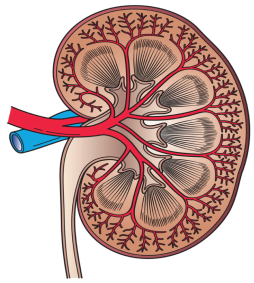
Draw the given diagram of L.S of kidney and label the following parts.
(a) Medullary pyramid
(b) Ureter


Answer
438.6k+ views
Hint: Two reddish-brown bean-shaped organs present in vertebrates are the kidneys. They are found in the retroperitoneal space on the left and right, and are around 12 centimeters (41⁄2 inches) in length in adult humans. Blood from the paired renal arteries is received; blood escapes into the paired renal veins. An ureter, a tube that takes the excreted urine to the bladder, is connected to each kidney.
Complete answer:
Two major structures separate the kidney: the outer renal cortex and the inner renal medulla. These structures take the form of eight to 18 cone-shaped renal lobes, each of which occupies a part of the renal cortex-covering medulla called a renal pyramid. Cortical projections called renal columns are situated in between the renal pyramids. Nephrons, the structural characteristics of the urine-producing kidney, span the cortex and medulla.
A renal corpuscle, which is situated in the cortex, is the initial filtering component of a nephron. A renal tubule that travels through the medullary pyramids well from the cortex is accompanied by this. Medullary rays, part of the renal cortex, are a series of renal tubules which flow into a single collecting duct.
Each pyramid's top, or papilla, empties urine into a small calyx; minor calyces empty into major calyces, and major calyces dump into the pelvis of the renal. The ureter becomes this. The ureter and renal vein at the hilum leave the kidney and join the renal artery. These structures are surrounded by Hilar fat and lymphatic tissue with lymph nodes. Hilar fat is contiguous with a space called the renal sinus that is fat-filled. Collectively, the renal sinus comprises the renal pelvis which calyx and divides these components from the medullary tissue of the renal.

Note: Since the kidney is unable to detect blood directly, long-term blood pressure control relies largely on the kidney. This happens mainly by the preservation of the extracellular fluid compartment, the scale of which depends on the concentration of sodium plasma. Renin is the first of a variety of major chemical messengers that make up the system of renin-angiotensin
Complete answer:
Two major structures separate the kidney: the outer renal cortex and the inner renal medulla. These structures take the form of eight to 18 cone-shaped renal lobes, each of which occupies a part of the renal cortex-covering medulla called a renal pyramid. Cortical projections called renal columns are situated in between the renal pyramids. Nephrons, the structural characteristics of the urine-producing kidney, span the cortex and medulla.
A renal corpuscle, which is situated in the cortex, is the initial filtering component of a nephron. A renal tubule that travels through the medullary pyramids well from the cortex is accompanied by this. Medullary rays, part of the renal cortex, are a series of renal tubules which flow into a single collecting duct.
Each pyramid's top, or papilla, empties urine into a small calyx; minor calyces empty into major calyces, and major calyces dump into the pelvis of the renal. The ureter becomes this. The ureter and renal vein at the hilum leave the kidney and join the renal artery. These structures are surrounded by Hilar fat and lymphatic tissue with lymph nodes. Hilar fat is contiguous with a space called the renal sinus that is fat-filled. Collectively, the renal sinus comprises the renal pelvis which calyx and divides these components from the medullary tissue of the renal.

Note: Since the kidney is unable to detect blood directly, long-term blood pressure control relies largely on the kidney. This happens mainly by the preservation of the extracellular fluid compartment, the scale of which depends on the concentration of sodium plasma. Renin is the first of a variety of major chemical messengers that make up the system of renin-angiotensin
Recently Updated Pages
Master Class 11 Economics: Engaging Questions & Answers for Success

Master Class 11 Business Studies: Engaging Questions & Answers for Success

Master Class 11 Accountancy: Engaging Questions & Answers for Success

The correct geometry and hybridization for XeF4 are class 11 chemistry CBSE

Water softening by Clarks process uses ACalcium bicarbonate class 11 chemistry CBSE

With reference to graphite and diamond which of the class 11 chemistry CBSE

Trending doubts
10 examples of friction in our daily life

One Metric ton is equal to kg A 10000 B 1000 C 100 class 11 physics CBSE

Difference Between Prokaryotic Cells and Eukaryotic Cells

State and prove Bernoullis theorem class 11 physics CBSE

What organs are located on the left side of your body class 11 biology CBSE

How many valence electrons does nitrogen have class 11 chemistry CBSE




